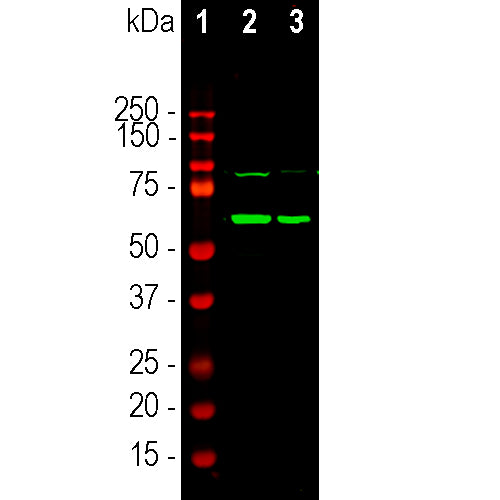

EnCor Biotechnology
Mouse Monoclonal Antibody to Tyrosine Hydroxylase (TH), Cat# MCA-4H2
Description
MCA-4H2 was made against full length recombinant human TH based on the 524 amino acid sequence in NP_954987.2, expressed in and purified from E. coli. The antibody works well for western blotting and for IF, ICC and IHC (for IHC see data under "Additional Data" tab). We also supply rabbit, chicken, and goat polyclonal antibodies to this protein, RPCA-TH, CPCA-TH, and GPCA-TH.
- Cell Type Marker
- Cytoplasmic Enzyme
- Developmental Marker
- Immunohistochemistry Verified
- Mouse Monoclonal Antibodies
- Pathology Related Marker
Add a short description for this tabbed section
| Immunogen: | Full length recombinant human TH as expressed in and purified from E. coli |
| HGNC Name: | TH |
| UniProt: | P07101 |
| Molecular Weight: | ~58kDa |
| Host: | Mouse |
| Isotype: | IgG1 heavy, κ light |
| Species Cross-Reactivity: | Human, Rat, Mouse |
| RRID: | AB_2737415 |
| Format: | Protein G affinity purified antibody at 1mg/mL in 50% PBS, 50% glycerol plus 5mM NaN3 |
| Applications: | WB, IF/ICC, IHC |
| Recommended Dilutions: | WB: 1:1,000-1:2,000. IF/ICC, and IHC: 1:1,000. |
| Storage: | Store at 4°C for short term, for longer term store at -20°C. Stable for 12 months from date of receipt. |
Tyrosine hydroxylase (TH) is a vital enzyme responsible for the generation of L-DOPA from the amino acid tyrosine. L-DOPA is the direct precursor of the neurotransmitter dopamine, and dopamine can itself be processed to produce the neurotransmitters adrenalin and noradrenalin (a.k.a. epinephrin and norepinephrin respectively). Neurons which use dopamine, adrenalin or noradrenaline, called collectively chatecholamines, must express TH. TH has a very restricted distribution in the brain but is highly expressed in the cells in which it is found. As a result antibodies to TH are useful for the identification of chatecholaminergic neurons. TH positive neurons in the rat are localized into clusters of cells most of which are in the brain stem, including notably the substantia nigra and locus ceruleus (1,2). The clusters of cells are usually referred to by a classification scheme based on that proposed by Dahlstrӧm and Fuxe, which labels cells in groups A1 - A17 and C1 to C3 (2). Subpopulations of neurons are localized in the olfactory bulb, habenula and retina. TH positive cells are also found in a subset of cells in the adrenal medulla, sympathetic ganglia, sensory ganglia and enteric ganglia (2). Numerous TH positive axons can be seen coursing through the striatum and to a much lesser degree the cortex originating from the mid brain A8, A9 and A10 nuclei. TH neurons have a huge impact on brain function and behavior but are relatively infrequent- the rat brain contains about 22,000 TH positive neurons in the A8, A9 and A10 nuclei out of a total of 200 million neurons (3). Parkinson's disease is caused by the loss of TH positive dopaminergic neurons in the substantia nigra, which are also relatively low in number (4), and perturbation of TH neurons has been implicated in Alzheimer's disease and schizophrenia (5-7). There is one mammalian gene which produces one mRNA transcript and one protein in rat but four alternate mRNA transcripts produce four slightly different forms of TH proteins in humans (8).

Chromogenic immunostaining of a 4% PFA fixed paraffin embedded rat brain section with mouse mAb to tyrosine hydroxylase, MCA-4H2, dilution 1:2,000, detected with DAB (brown) using the the Vector Labs ImmPRESS method and reagents with citrate buffer retrieval. Hematoxylin (blue) was used as the counterstain. In this image, MCA-4H2 strongly labels catecholaminergic neurons within the substantia nigra. This antibody has not been tested in NBF fixed material. Mouse select image for larger view.

Above is an image made by Dr. Fatimeh Shaerzadeh, working in the lab of Professor Habibeh Khoshbouei in the McKnight Brain Institute of the University of Florida. A section of mouse midbrain stained with EnCor mouse monoclonal antibody to tyrosine hydroxylase MCA-4H2 in green. The cytoplasm and processes of these dopaminergic neurons are revealed. Mouse select on image for larger view.
1. Pickel VM, et al. Cellular localization of tyrosine hydroxylase by immunohistochemistry. J. Histochem. Cytochem. 23:1-12 (1975).
2. Bjorklund A, Dunnett SB. Dopamine neuron systems in the brain: an update. Trends Neurosci. 30:194-202 (2007).
3. German DC, Manaye KF. Midbrain dopaminergic neurons (nuclei A8, A9, and A10): three-dimensional reconstruction in the rat. J. Comp. Neurol. 331:297-309 (1993).
4. Daubner SC, Le T, Wang S. Tyrosine hydroxylase and regulation of dopamine synthesis. Arch. Biochem. Biophys. 508:1-12 (2011).
5. Haavik J, Toska K. Tyrosine hydroxylase and Parkinson's disease. Mol. Neurobiol. 16:285-309 (1988).
6. Torack RM, Morris C. Tyrosine hydroxylase-like (TH) immunoreactivity in Parkinson's disease and Alzheimer's disease. J. Neural Transm. Park. Dis. Dement. Sect. 4:165-71 (1992).
7. Benes FM, Todtenkopf MS, Taylor JB. Differential distribution of tyrosine hydroxylase fibers on small and large neurons in layer II of anterior cingulate cortex of schizophrenic brain. Synapse 25:80-92 (1997).
8. Lewis DA, Melchitzky DS, Haycock JW. Four isoforms of tyrosine hydroxylase are expressed in human brain. Neuroscience 54:477-92 (1993)
Add a short description for this tabbed section





